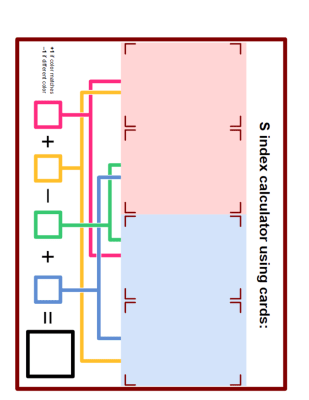The field of Quantum Information Science (QIS) is an area of research that brings together ideas from science, engineering, and technology. It studies how we can take advantage of the special and strange behaviors of quantum (tiny) things – like atoms – to build better tools for technology and information. These tools could include more powerful computers, more secure ways of sending information (like secret messages), and more precise measuring devices.

Entangled and shuffled
Exploring quantum correlations and entanglement through tabletop games
What makes quantum particles and systems different from normal objects?
- Provided in kit:
- Deck of playing cards
- Pen/pencil and paper
- S index calculating boards (one per student pair - laminated or in sheet protectors)
- Teacher provided:
- Dry erase markers
- Dry erase board cleaner
During the last century, the development of lasers and transistors led to an explosion in the availability of technology and information circulating around the world. This has strongly reshaped our societies, and we call this new era the “information age.” Right now, all the information we use in computers is stored, shared, and received using a basic system of “ON” and “OFF” signals, or 0s and 1s. These states of information are called bits, and they’re the building blocks of regular (or “classical”) computers.
Classical computers seem really complex, but that’s mostly because they handle tons of bits super quickly – not because the fundamental parts of our computers are very advanced. The problem is, as society grows, we need to process more and more information, and the amount of memory and power that we need grows exponentially. Eventually, our current technology will not be able to keep up with society’s needs. That’s why people are interested in QIS: quantum bits have special properties, and can process more complex information with less power.
- Students will play a few games that will allow them to make connections between regular items like playing cards and the behavior of quantum particles.
- Through the game, students will learn some of the differences between regular, everyday systems and quantum technologies.
- Students will learn how to calculate correlations for non-entangled and entangled scenarios using playing cards
You can create your own objectives too. After reading the introduction, what is your essential question or objective for this activity?
Think about it: What do you think it means for particles to be “entangled” on a quantum scale? This is a new concept you probably haven’t heard much about, so all ideas are good ones!
Get two portions of a deck of cards from your teacher (deck one and deck two).
Get an S index board and dry erase markers (if laminated) or pen (if printed).
Split deck one into two parts. Take the first card from each side and turn face up. Observe the numbers and colors of each card.
Continue flipping the top card face-up and observing the numbers and colors.
Do you see any patterns in the pair of cards with regards to color, number, etc.?
Record your observations in your notebook.
Repeat steps one through four with deck two. You can use a table like the one below if you’d like.

Discuss your findings with your classmates and the teacher.
There is an online version of this section of the activity that can be found here.
Get a deck (or portion of a deck) of shuffled cards.
Draw four cards from the shuffled deck and lay them on the board.
Calculate the correlation indices according to the rule:
- Same color = +1
- Different color = -1
Add the four different correlation indices using the pattern C1 + C2 – C3 + C4 as indicated on the board.
Take the absolute value of the outcome. We will refer to the result as the “S index.”
Share the results.
Play a few different rounds.
Try hand-picking cards instead of shuffling them. Does this change the possible outcomes?
Answer these questions to the best of your ability using what you learned today during this activity and the information in the introduction. Discuss the answers with your class and teacher.
- What does it mean for two particles to be correlated? Use evidence from this experiment to support your definition.
- Debate with your partners the following question:
- Before the card is turned over, what color is it?
- Use your answers to help you define the word superposition.
- What happens to the value of S in the card game when playing under the regular rules, and why can’t it be larger than two?
- How does the concept of “quantum cards” differ from regular cards in the game? Why might this allow for a value of S greater than two?
- How is the card game related to quantum computers and classical computers? Explain how qubits in quantum computers can surpass the limitations of classical bits.
- Was your personal essential question answered? If so, what is the answer? If not, what additional information would you need to answer it?
